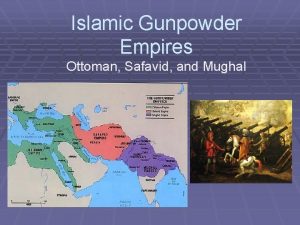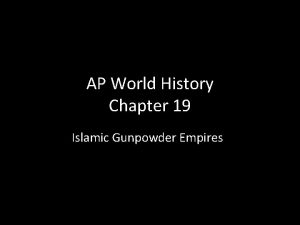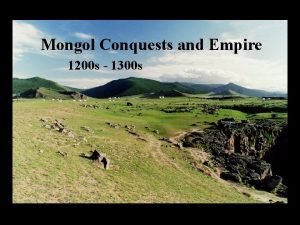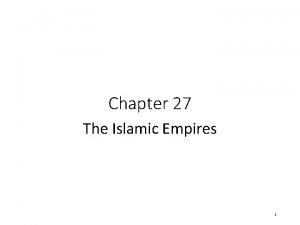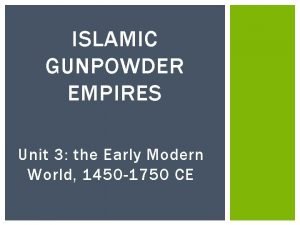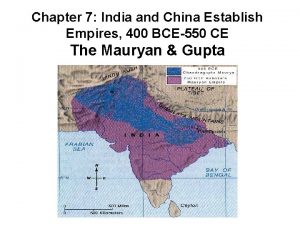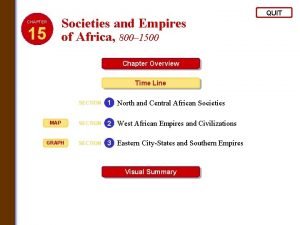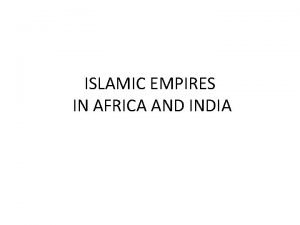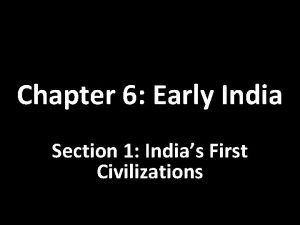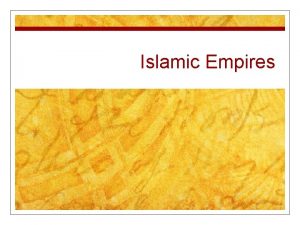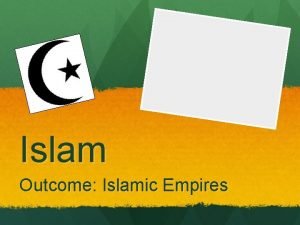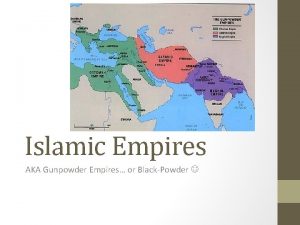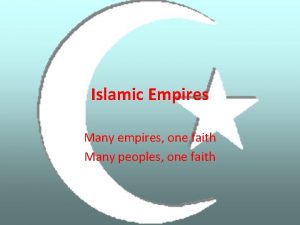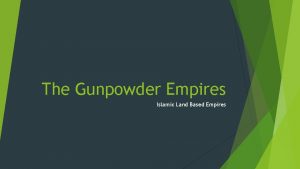ISLAMIC EMPIRES IN AFRICA AND INDIA WEST AFRICA











- Slides: 11

ISLAMIC EMPIRES IN AFRICA AND INDIA

WEST AFRICA (MALI) 1200 -1450 • Replaced Ghana, but LARGER and MUSLIM • Grew from Sub-Saharan trade route – controlled gold fields • Sundiata founded empire and took over cities such as Gao, Jenne • Griots – oral historians told stories of Sundiata • He created basic rules and relationships of society – clans & jobs, crime punished

MANSA MUSA • Mansa (“emperor”) Musa pilgrimmage to Mecca showed wealth • Ibn Battuta saw Mali’s government as safe (p. 378)

Timbuktu – Sankore Mosque Timbuktu became a great trading and financial capital and later a center of learning: universities, libraries and over 150 schools devoted to the Qur’an.

SONGHAY • Songhay replaced Mali in Niger valley • Sunni Aki took over Timbuktu and Jenne • A fusion of Islamic, pagan and African traditions…local interpretation meant that men and women mixed freely, women went unveiled – often matrilineal

INDIA – DELHI SULTANATE • Indian Islam more violent than Africa – Hindu’s never forgave the violence (problems later) • NORTHERN INDIA: Sultan Iltutmish became a benign ruler – gave throne to daughter Raziya • Raziya never accepted: later Sultan Muhammad ibn Tughluq (tolerated other religions) and Sultan Firuz Shah (no toleration, taxed Brahmins) • Islam helped centralize political authority

INDIAN OCEAN TRADE • 1200 -1500: more trade in Indian Ocean • Dhow produced in SW India on Malabar coast • Junks were larger and developed in China • Ibn Battuta describes 12 sails, 1000 men crew • Trade decentralized and cooperative

SWAHILI/ZIMBABWE AND ADEN • Swahili cities such as Kilwa exported gold near Great Zimbabwe (GZ) • GZ economy: agriculture, cattle herding, trade Great Zimbabwe declined because of deforestation • Aden: S. Arabia: rainfall for drinking water, grain – stopover for trade from India to Africa • “sorting spot” (cotton-India; spices-SE; horses-Arabia; pearls-Red Sea; slaves/gold/ivory-Ethiopia; grain & opium)

MALABAR COAST and MALACCA • INDIA: Malabar Coast – Trade included: cotton, leather skins, embroidey, gold thread, linen, silk, gemstones, jewelry, ivory, beads • Calicut, Cambay • SE ASIA: Malacca - Sumatra and Siam – Islamic trade instead of Hindu helped it grow

SOCIAL & CULTURAL CHANGES • Islamic influence in Africa & Asia saw changes in architecture – rock carving in Africa • Islam brought literacy to Africa (arabic script) • Islam brought study of law, administration, math, medicine, Greek science • Delhi, Timbuktu & Malacca learning centers • Islam usually spread peacefully through trade, marriage but developed differently by adopting local practices

SOCIAL AND GENDER DISTINCTIONS • Elites and commoners gap widened with wealth of trade • In India, some lower castes adopted Islam as it offered “hope” from inequalities of Hinduism • Slavery increased in Africa and India • Slaves were often trained for special purposes • Women’s status determined by males: India women expected to marry before puberty • African Muslim women: not required veil, could interact with men
 How were land based and maritime empires similar
How were land based and maritime empires similar Islamic gunpowder empires ottomans safavids and mughals
Islamic gunpowder empires ottomans safavids and mughals Chapter 19 islamic gunpowder empires
Chapter 19 islamic gunpowder empires Islamic gunpowder empires webquest
Islamic gunpowder empires webquest Chapter 27 the islamic empires
Chapter 27 the islamic empires Chapter 27 the islamic empires
Chapter 27 the islamic empires Empires
Empires Chapter 7 india and china establish empires
Chapter 7 india and china establish empires Chapter 15 societies and empires of africa
Chapter 15 societies and empires of africa India empires
India empires Chapter 7 section 1 india's first empires
Chapter 7 section 1 india's first empires Chapter 7 section 1 india's first empires
Chapter 7 section 1 india's first empires

